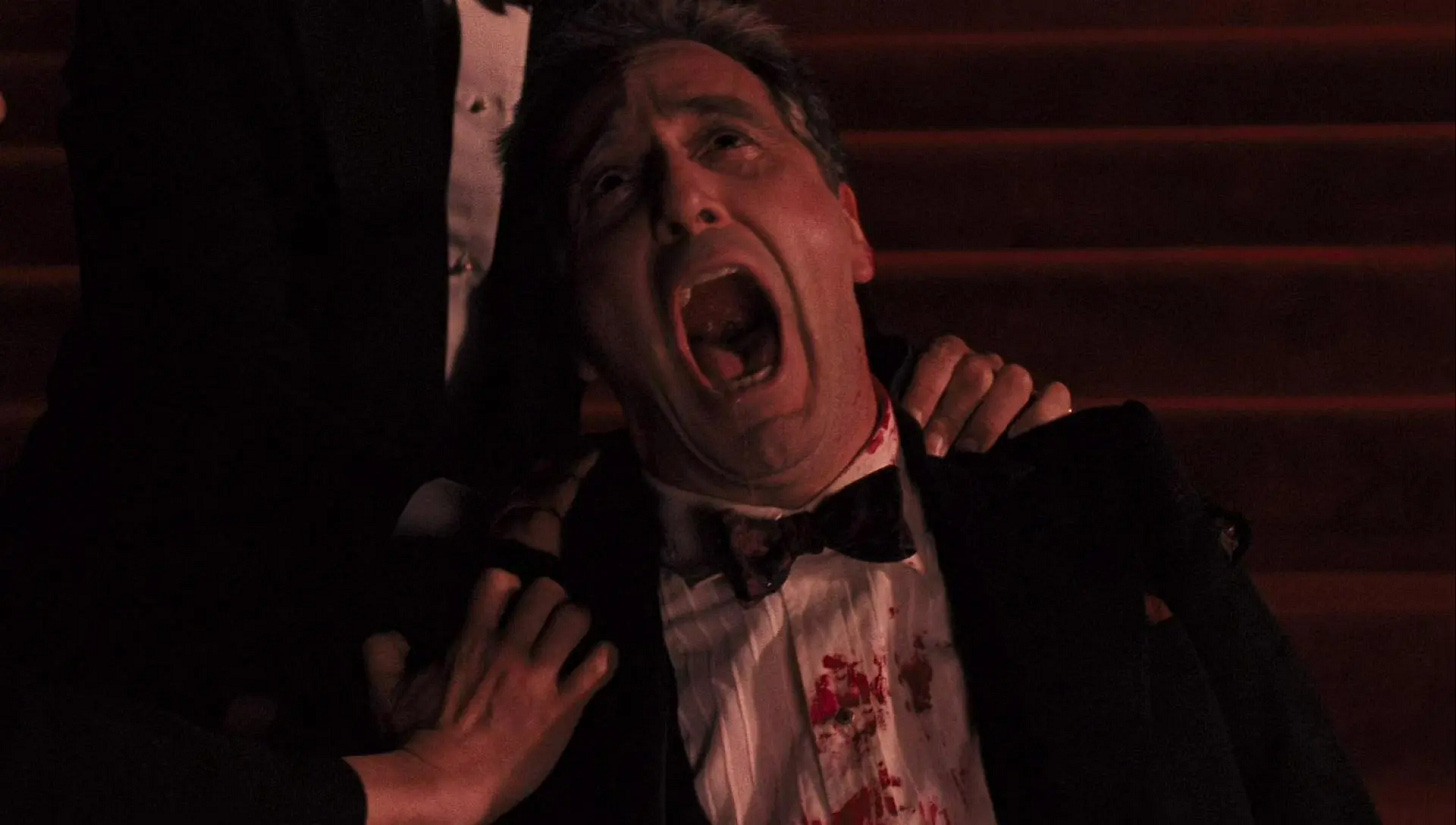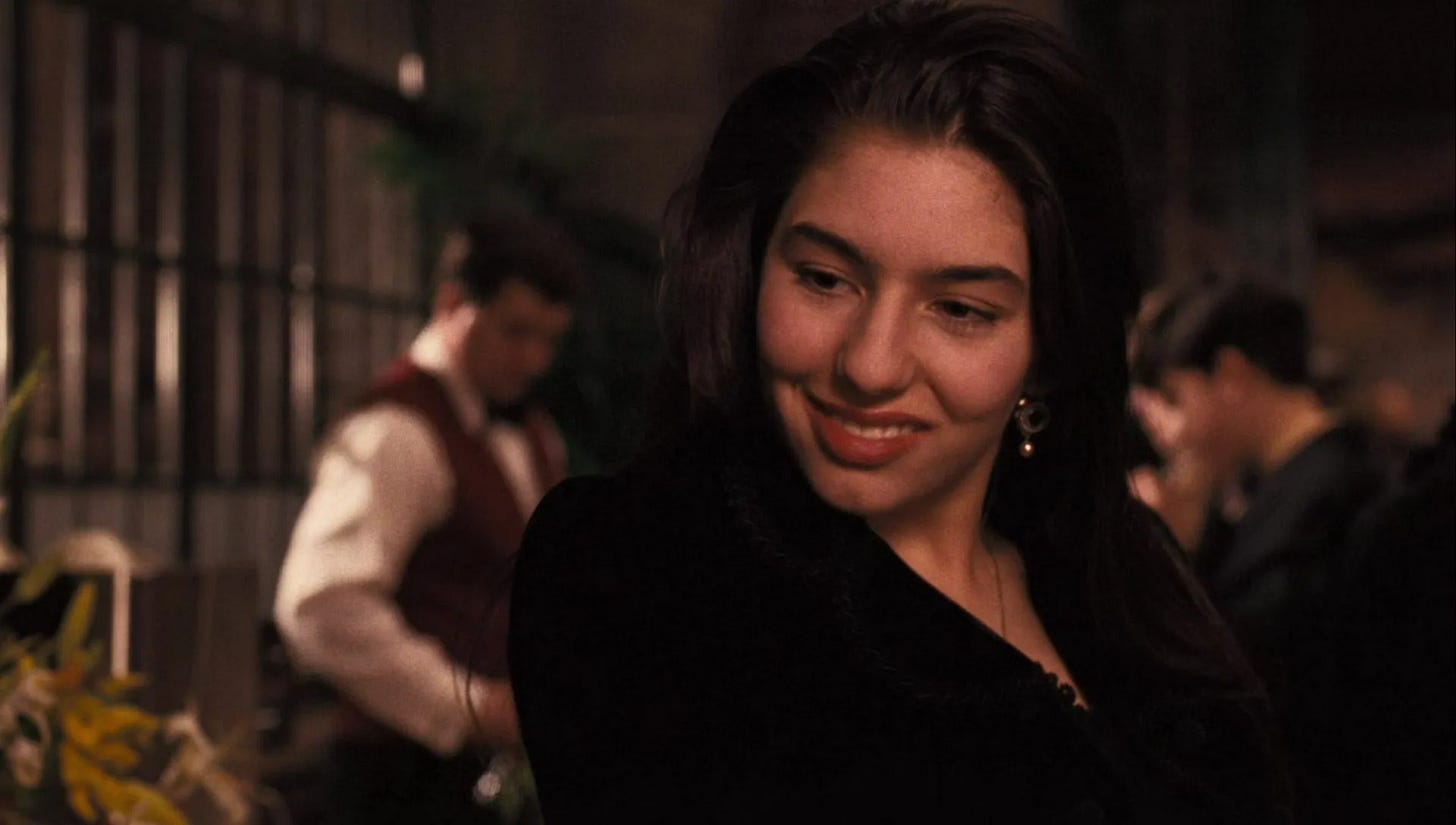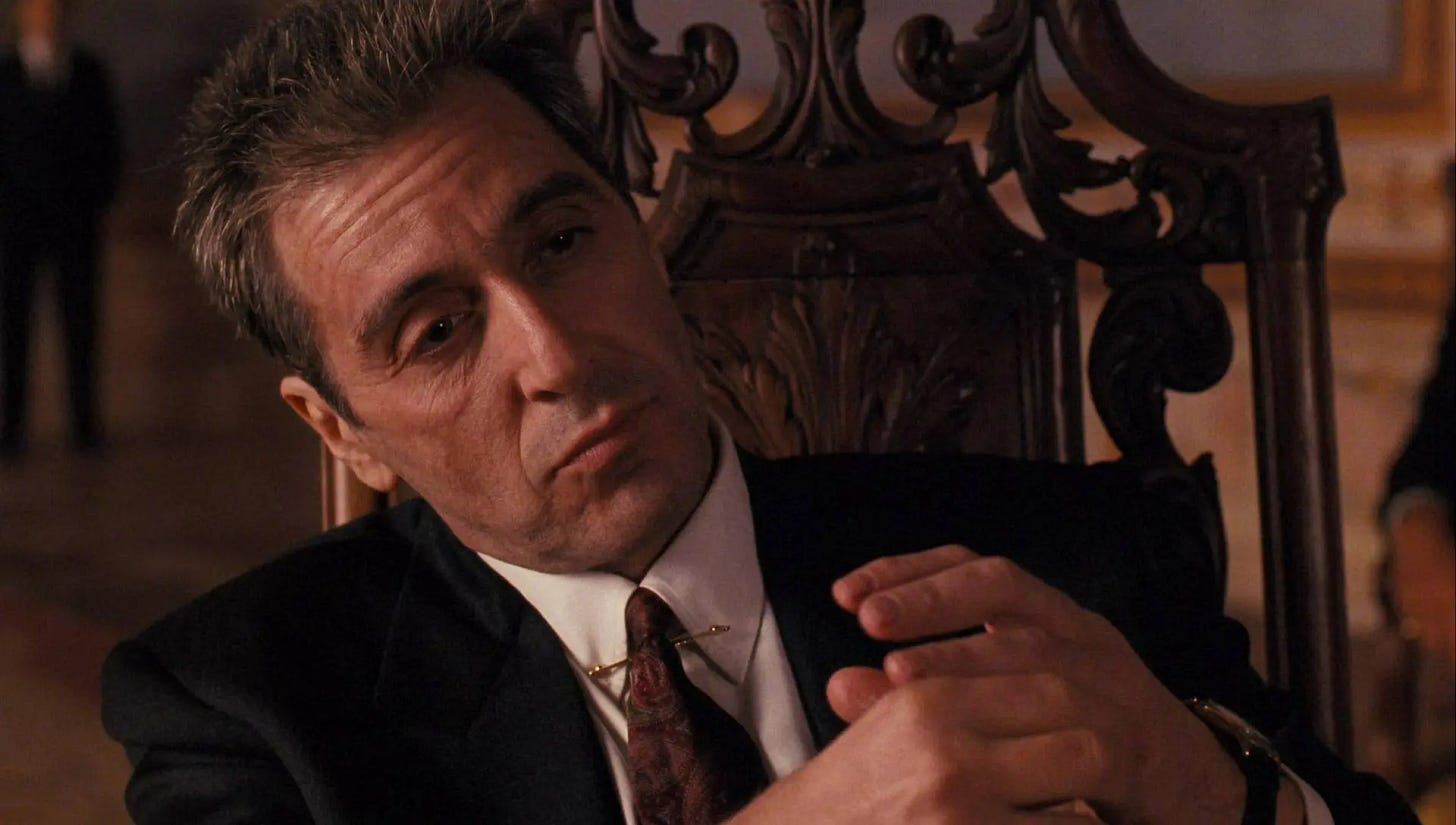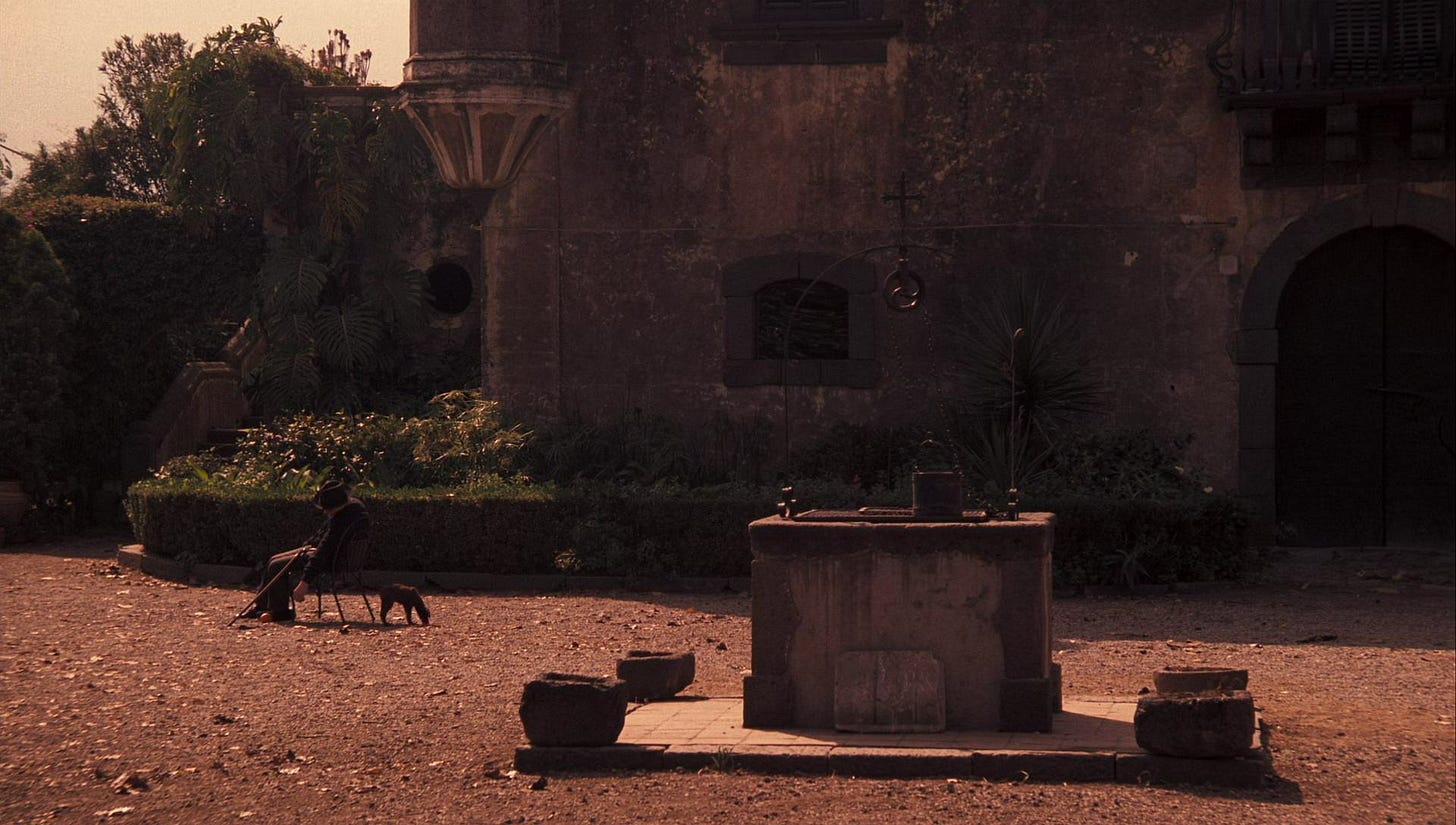Review: "The Godfather Part III" is bad, and Coppola's tinkering has made it worse
Movie of the Week #9 is a film that's even worse than you remember
Welcome to Movie of the Week, a Wednesday column where we take a look back at a classic, obscure, or otherwise interesting movie each and every week for paid subscribers. Follow this link for more details on everything you get subscribing to Fade to Lack!
The Godfather Part III is a terrible movie – not just by the standards of the Godfather films that preceded it, but by any metric – and Francis Ford Coppola’s subsequent tinkering has only made it worse.
The film that arrived in theaters in 1990 is a mess. Its plot is needlessly convoluted and poor at communicating its own narrative or stakes, and the structure and pace have none of the elegance of the first film, let alone the mastery of the second. The original cut is shorter than either of the 1970s films, but feels far longer. Having only three returning actors from the earlier movies – Al Pacino, Diane Keaton, and Talia Shire – really hurts the sense this is a continuing story, with the absence of Robert Duvall in particular felt powerfully. Two of those three act fundamentally out of character; the idea that Connie (Shire) doesn’t believe Michael killed Fredo – or, at least, chooses not to acknowledge it, and has instead stuck close to Michael ever since – is a deeply bizarre character choice given Connie was the member of the Corleone family who saw clearest through Michael’s exterior to the monster underneath. And that has nothing on the character assassination of Kay (Keaton), a woman who was so clear eyed about Michael’s evil that she aborted his baby rather than bring more of him into the world, here reduced to a hopeless nostalgic tearfully admitting “I’ll always love you.”
And that instinct – to have characters like Kay and Connie give Michael additional chances when the character is so far past the possibility of forgiveness – is Part III’s ultimate Achilles heel. I know the film does not ultimately redeem Michael – it damns him, albeit through the death of his daughter – but the fatal flaw, to me, is that it even entertains the idea of redemption for so much of its runtime. Pacino does his absolute best to sell what Coppola gives him, but Parts I and II were at their core about a man who methodically cordons off parts of his soul until he is so cold he can kill his own brother. A person who can do that is not someone who wants, or probably even thinks he needs, redemption – that’s the point of the journey traced in those earlier films. There is no story to tell here, but even if there was, this certainly isn’t it.
The film tries on multiple occasions to recreate the magic of iconic scenes from the first two films, and each instance just underlines the width of the chasm separating these works. Vito’s assassination of Fanucci amidst the neighborhood festa is recreated here when Vincent kills Joey Zasa, and the whole thing is just sad; a once-great director limply restaging the best scene of his career, and coming up totally empty, almost as if this is a direct-to-video rip-off rather than an honest-to-God sequel. And that scene has nothing on the abject mess that is the Opera climax in Rome, which is endlessly long and horribly paced, a stop-start mess where all the moving parts feel exhausting rather than exhilarating. It has none of the fluidity or gracefulness of the baptism climax from Part I, going on and on and on with dozens of parallel cuts before any of the action actually goes down; and when the bullets start flying, the cast at this point is so thin that we don’t know any of the characters doing the killing. Instead of Clemenza climbing the stairs to strangle Connie’s abusive husband Carlo, it’s a procession of glorified extras criss-crossing, the viewer unable to keep any of it straight.
All of which is to say: It says a lot about the depths of misogyny in film culture that Sofia is the Coppola who has somehow received the brunt of criticism and mockery in the years since Part III released. Fun fact: she didn’t direct herself! The truth is that Papa Coppola’s directing of actors throughout the movie is extremely poor. Shire, for instance, is a manifestly talented performer, but here she’s saddled with a deadly combination of bad dialogue and worse direction leading to unintentionally ridiculous moments like shouting “IT’S HIS DIABETES!” when Michael collapses. Even Pacino and Andy Garcia (the newcomer who fares best here) suffer from weird blocking in places; take a look at the scene where Kay visits Michael in the hospital, and note that the eyelines are all off throughout.
Moreover – and there’s no non-awkward way to put this – it is genuinely jaw-dropping how all-in Part III goes on cousin incest from the very beginning. The introduction to Michael’s daughter Mary is poor Sofia Coppola being directed to seductively say the line “relatives always kiss” while flirting with Vincent (Garcia). Every single scene that follows in Mary and Vincent's courtship – Every. Single. One. – goes out of its way to remind the viewer that these people are, indeed, first cousins. They only refer to each other as 'cousin,' 'cous,' or the Italian 'cugina/o', constantly reference 'our family,' 'our fathers,' 'our grandfather,' and so on, without there ever being an intimation that any of this is wrong. It is presented as, at most, a comedic obstacle in an otherwise straight-faced, charming romance, one Michael requires Vincent to break off not because they are cousins, but because Vincent is going to take over the dangerous job of Godfather; in fact, Mary only dies at the end because she is standing in the way of the bullet while imploring her father to let her date her first cousin, implying that if Michael had just taken a blind eye to the whole ‘incest’ thing, the final tragedy would never have struck.
Here is an actual exchange of dialogue from The Godfather Part III:
Mary: “I love my family.”
Michael: “Even your cousin Vincent?”
Mary: “I really love him.”
Michael: “He’s your first cousin.”
Mary: “Then I love him first!”
I don’t know if those lines would belong better in a sitcom with a laugh track or in the opening to a porno, but it definitely feels out of place in a Godfather sequel. By the time Mary and Vincent are passionately kissing while exchanging explicitly incestuous declarations of love – “I love you, cous” / “I love you too, cous” – I am asking myself what the hell I am watching, and wondering why it isn’t behind an age verification screen.
So yeah. The Godfather Part III has problems. They weren’t rectified by Coppola’s choice to add 9 additional minutes to an already overlong movie for home video – this was the only version available from 1991 to 2020 – and they definitely weren’t solved by his (so far) final bit of tinkering, a 2020 Director’s Cut produced for the 30th anniversary that rechristened the film as – deep breath – Mario Puzo’s The Godfather, Coda: The Death of Michael Corleone. It is emphatically the worst version of an already troubled movie, a cut that does not (and cannot) fix any of the actual problems the movie had; what fiddling it does is frankly embarrassing.
Most of the film is unchanged save for some trimmed and rearranged scenes. Some of that streamlining is good, but most of it goes unnoticed. The big changes are to the opening and closing. The former is a decent idea poorly executed; the latter is laughably inept. For the opening, Coppola takes the scene where Michael negotiates to give the Vatican $500 million (which comes about 40 minutes into the theatrical cut) and moves it up to the very beginning. The intent is clear: It streamlines and clarifies the Vatican plot, and echoes the structure of the first Godfather, with someone making a request of Don Corleone (Vito there, Michael here). That's a good idea in theory, but very awkward in execution. First, the scene was never shot to be the intro – this is a choice Coppola made 30 years after the fact – and the footage does not exist to make it feel like a natural starting point. The first scene of the original Godfather starts with a long, moody camera pull-out for a reason, and Coppola lacks the coverage here to make a similar effect. Second, Coppola then maintains Michael's narration of his letter to his children, the introduction to the theatrical and 1991 cuts, positioned as the second scene here; it is very whiplash-y, because as narrated and edited, this is clearly an introductory scene, now coming 10 minutes in. It doesn't work.
More importantly, if this change clarifies the plot, it sacrifices theme and atmosphere to get there. The earlier cuts of Godfather III open with shots of the lake house where Fredo was killed, now abandoned. It's haunting. From here we hear the narration of Michael's letter, and we then go to Michael getting the medal from the Vatican. This procession of scenes immediately establishes Michael's state of mind: that he is still stuck in that moment of killing Fredo, unable to move past it. It also establishes that all his charitable giving is his attempt to atone, a vital character dynamic completely lost in the Coda cut. The original opening is better: as the start of its own movie, as a sequel, as characterization for Michael, as the beginning of this story. Perhaps if the film had been rewritten to accommodate this shift before filming in 1990, the idea the Coda cut goes for could work. But you can’t plaster it together in 2020.
The ending, though, is where Coppola really goes off the rails. It starts out mostly the same, with Mary’s death and Michael’s wailing, but when we fade to the flashbacks, we only see images of Michael and Mary from earlier in the movie (the earlier cuts also show Michael’s previous lovers, Appolonia and Kay – all the other good women he lost for his sins). As in the original, we then move forward in time to old Michael in Sicily, but here, Coppola reverses the final two shots of the movie. In the original, we have a close-up on Michael’s aged face, then a long shot of him slumping over in the distance. Here, we start with the long shot, but cut to the close-up before he slumps down – a reversal that plays very awkwardly if one knows the original.
This isn’t actually the worst part though. From the close-up, Coppola fades to black; the musical cue is unchanged, though, so there is time left over from cutting the part where Michael falls down, dead. In that space, while the score continues, Coppola inserts these two lines of text:
When the Sicilians wish you ‘Cent’anni,’ it means ‘for long life.’
… and a Sicilian never forgets.
Why? Why, Francis, why?
First, this is a rhetorical technique the Godfather films have never used before (there is on-screen text at the start of Part II, but it is purely expository). Second, this is every bit as subtle as Coppola bursting through the screen Kool-Aid man style screaming “DID YOU GET IT?!? GUYS? DID YOU GET IT!?”
The original version isn’t exactly subtle, but it is clear and competent visual storytelling: an old Michael sits alone, lost in memories of all the women he got killed or pushed away, and finally slumps down dead, in a long shot emphasizing the emptiness around him. It is good, clean filmmaking, using cinematography and mise-en-scene to impart a message. The other is incompetent and amateurish, revealing that Coppola apparently thinks the problem with Part III was that he didn’t spell out clearly enough the point of his already excessively obvious movie. There are large swaths of Part III where it already feels like Coppola has completely forgotten how to direct a film (he hadn’t, as we’ll see with next week’s movie). But tack another 30 years on top of that? Oof. These are not the choices of someone who should still have creative control of their past work.
And look, at the end of the day, Coppola gets an artistic pass. He made Godfather I, Godfather II, The Conversation, and Apocalypse Now all in a row. That's enough to get in the Hall of Fame several times over, no matter what came after.
But boy howdy do I thank God he hasn’t decided to recut Parts I and II.
NEXT WEEK: In anticipation of Coppola’s latest and, apparently, weirdest film - Megalopolis - we take a look at one of his other most bonkers efforts (and the film he made after Godfather III): 1992’s Bram Stoker’s Dracula.
Read the book 200 Reviews by Jonathan R. Lack in Paperback or on Kindle
Like anime? Listen to the podcast I host with Sean Chapman, JAPANIMATION STATION, where we review all sorts of anime every week. Watch on YouTube or Subscribe wherever you get your podcasts.





